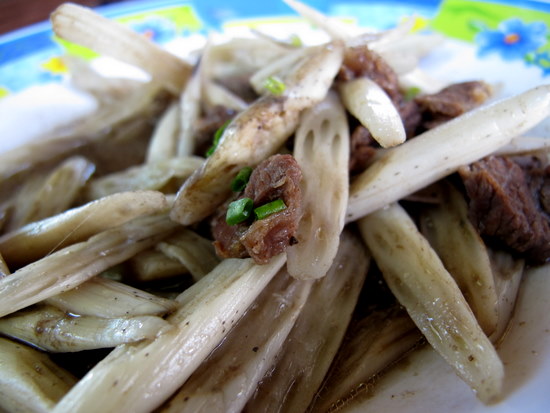 |
| Beef and lotus rootlet char, from a roadside stall in Kandal province. |
But on an average day, for an average Cambodian, char is what's on the menu. Char just means stir-fry in Khmer, and if you look in any of the handful of Cambodian cookbooks that are out there, you won't see very much of it. That's because char dishes are too simple, too, dare I say, boring, to make it into the cookbooks (haven't you heard that Cambodian is going to be the new Vietnamese?) So cookbooks focus on special occasion food, royal cuisine and the dishes that seem more exotic, and ignore what Srey Oun and her family are having for dinner.
 |
| Lunch in the provinces: bitter melon soup, char made from crabs picked out of the rice paddy, snails, tomato and pork char and lots of rice. |
Here's what's in most char dishes. One type of meat or fish, and one type of vegetable. The protein can consist of frog, chicken, crabs, fish, prawns, pork, squid, eel, liver, clams, snails or beef. The vegetable might be one of the following: cucumbers, winter melon, tomatoes, Kampot pepper, eggplant, lotus rootlet, baby corn, pumpkin, peppers, chives, mushrooms, papaya, water spinach, mango, ginger, green beans, pineapple, bok choy, bean sprouts, lemongrass, daikon, squash or chayote. Other vegetables and herbs are used in Cambodian cooking, of course, but these are the ones that are most often used in a char dish.
 |
| Barely ripe tomato and pork char with scallions. |
 |
| After taking the weekend off from office work, Rina goes home to work the rice paddy and make lunch. |
Some chars will have two types of vegetables, but usually it's just one, and it's always one type of meat. Whereas westerners use vegetables to garnish huge steaks, Cambodians use small pieces of meat to add flavor to vegetables. Chars are usually mostly vegetables with some small bits of meat thrown in. When I was out in Kandal province with my friend Rina, we went shopping together (by shopping I mean picking over the fly-infested pork her neighbor had brought over from town a few hours earlier). For a group of 9 or 10 people, most of them adults and most of them having spent the morning doing grueling work in the rice paddies, Rina bought a piece of pork that was probably 4 ounces, half the size of an average steak in the States.
 |
| Lunch in the provinces: a char made from a vegetable called nor nung and beef. |
 |
| Cucumber, tomato and chicken char made by your truly, in an attempt to find an Asian husband. |
Perhaps unsurprisingly, I've completely assimilated to Khmer culture, and make char for dinner all the time. It's simple and delicious, and worthy of being in the Cambodian cookbooks. You can find dozens of char recipes at this fantastic site, khmerkromrecipes.com.
This is not the sort of dish that really requires a recipe, but here's one I wrote down while watching Rina cook up a storm for her family.
Cambodian Char
3-4 cloves garlic, roughly chopped
vegetable oil
pork, chicken or beef cut into thinnish pieces
fish sauce, to taste
1 or 2 tsp sugar
1 small tsp MSG (optional, of course)
2 cups vegetable of choice, such as tomato, cucumber, melon, green papaya
black pepper
scallions, chopped
Heat up your wok and add oil. When it's hot, add the garlic. A minute later, add the pork. Cook for a minute or two, then add the fish sauce, sugar and MSG.
Add one cup of water and the vegetables.
Cook 2-3 minutes or until everything is done (but not overdone!)
Add black pepper and garnish with chopped scallions.
Serve with rice.
So healthful and high fiber! No wonder the consumers look so much more attractive than people in the US.
ReplyDeleteHuh. High fiber is not a word I would use to describe the typical Cambodian meal. I think that "unfed" is they key to so many Khmer's attractiveness. If you scan the politicians, you will see a much more rotund group.
ReplyDeleteIs this by way of saying that given a choice they would end up as pudgy as their rulers? Dishes that are mostly composed of vegetables would seem to qualify as "high fiber".
ReplyDeleteahh...worlds apart...still, I consider lotus roots to be the swine of the tubar world.
ReplyDelete